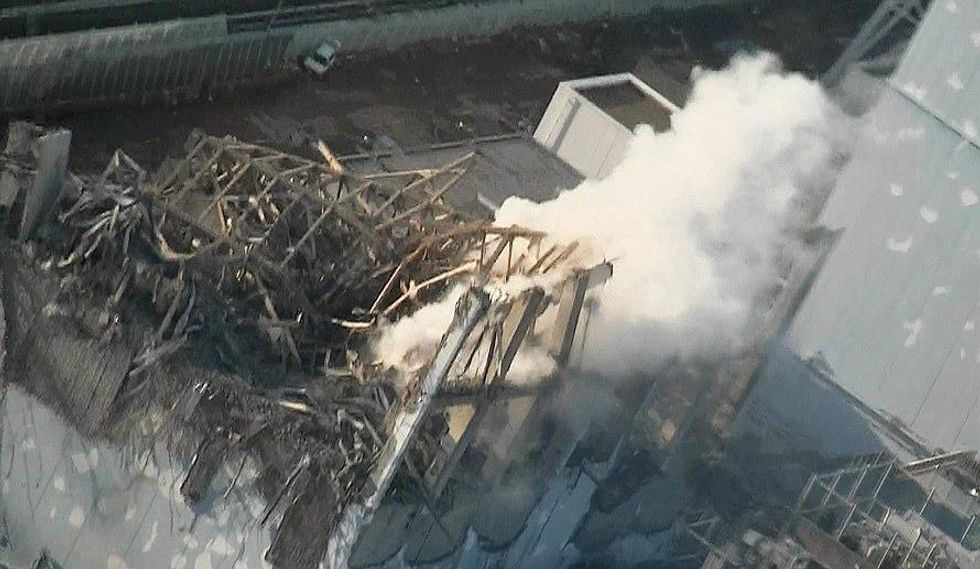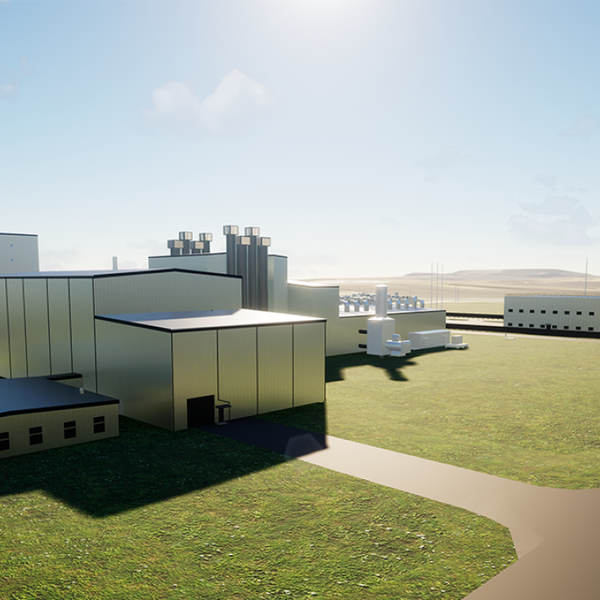TEPCO Official: Fukushima is Out of Control
Statement contradicts assurances of Japanese PM, comes as fresh steam is spotted billowing from reactor

Those were the words of Kazuhiko Yamashita, executive-level fellow for Fukushima plant operator Tokyo Electric Power Company when he was pressed by the opposition Democratic Party of Japan.
His statements directly contradict the claims of Japanese Prime Minister Shinzo Abe, who assured the International Olympic Committee meeting in Buenos Aires Saturday that the situation is under control.
TEPCO officials moved quickly to cover Yamashita's tracks, releasing a statement Friday declaring
It is our understanding that the Prime Minister intended his statement 'the situation is under control' to mean that the impact of radioactive materials is limited to the area within the port of the power station, and that the densities of radioactive materials on the surrounding waters are far below the referential densities and have not been on continuous upward trends. According to this understanding, we share the same views.
Yet, all evidence suggests that the crisis is far beyond the current abilities of the Japanese government and operator TEPCO to contain it.
Each day brings new disasters, with fresh reports on Friday that steam is billowing from a reactor. Radiation levels at the plant were found to be 18 times higher than TEPCO previously claimed, climbing to a high of 1800 millisieverts per hour--enough to kill a person in just four hours.
TEPCO has poured thousands of tons of water to cool the melted reactors, yet has no sustainable plan for storing it once contaminated. The temporary tanks where the radioactive water is currently being held are springing leaks, releasing the water into the groundwater, and by extension, the sea. TEPCO says it has resorted to patching tank leaks with plastic tape.
The Japanese government announced in early September it will invest $500 million to build a giant 'wall of ice' surrounding the plant. Yet, experts predict it will take at least 2 years to complete, and there is no evidence that this is enough to stem what has become a ballooning crisis.
The disaster was touched off by Japan's March 2011 earthquake and tsunami that led to the meltdown of fuel-rods at several reactors and continues to unleash toxic radiation into the air and sea. Over 160,000 people have been evacuated, transforming nearby areas into ghost towns in the worst nuclear disaster since Chernobyl. The Japanese government has been criticized for moving to re-start other nuclear facilities as the Fukushima crisis spirals.
_____________________
An Urgent Message From Our Co-Founder
Dear Common Dreams reader, The U.S. is on a fast track to authoritarianism like nothing I've ever seen. Meanwhile, corporate news outlets are utterly capitulating to Trump, twisting their coverage to avoid drawing his ire while lining up to stuff cash in his pockets. That's why I believe that Common Dreams is doing the best and most consequential reporting that we've ever done. Our small but mighty team is a progressive reporting powerhouse, covering the news every day that the corporate media never will. Our mission has always been simple: To inform. To inspire. And to ignite change for the common good. Now here's the key piece that I want all our readers to understand: None of this would be possible without your financial support. That's not just some fundraising cliche. It's the absolute and literal truth. We don't accept corporate advertising and never will. We don't have a paywall because we don't think people should be blocked from critical news based on their ability to pay. Everything we do is funded by the donations of readers like you. Will you donate now to help power the nonprofit, independent reporting of Common Dreams? Thank you for being a vital member of our community. Together, we can keep independent journalism alive when it’s needed most. - Craig Brown, Co-founder |

Those were the words of Kazuhiko Yamashita, executive-level fellow for Fukushima plant operator Tokyo Electric Power Company when he was pressed by the opposition Democratic Party of Japan.
His statements directly contradict the claims of Japanese Prime Minister Shinzo Abe, who assured the International Olympic Committee meeting in Buenos Aires Saturday that the situation is under control.
TEPCO officials moved quickly to cover Yamashita's tracks, releasing a statement Friday declaring
It is our understanding that the Prime Minister intended his statement 'the situation is under control' to mean that the impact of radioactive materials is limited to the area within the port of the power station, and that the densities of radioactive materials on the surrounding waters are far below the referential densities and have not been on continuous upward trends. According to this understanding, we share the same views.
Yet, all evidence suggests that the crisis is far beyond the current abilities of the Japanese government and operator TEPCO to contain it.
Each day brings new disasters, with fresh reports on Friday that steam is billowing from a reactor. Radiation levels at the plant were found to be 18 times higher than TEPCO previously claimed, climbing to a high of 1800 millisieverts per hour--enough to kill a person in just four hours.
TEPCO has poured thousands of tons of water to cool the melted reactors, yet has no sustainable plan for storing it once contaminated. The temporary tanks where the radioactive water is currently being held are springing leaks, releasing the water into the groundwater, and by extension, the sea. TEPCO says it has resorted to patching tank leaks with plastic tape.
The Japanese government announced in early September it will invest $500 million to build a giant 'wall of ice' surrounding the plant. Yet, experts predict it will take at least 2 years to complete, and there is no evidence that this is enough to stem what has become a ballooning crisis.
The disaster was touched off by Japan's March 2011 earthquake and tsunami that led to the meltdown of fuel-rods at several reactors and continues to unleash toxic radiation into the air and sea. Over 160,000 people have been evacuated, transforming nearby areas into ghost towns in the worst nuclear disaster since Chernobyl. The Japanese government has been criticized for moving to re-start other nuclear facilities as the Fukushima crisis spirals.
_____________________

Those were the words of Kazuhiko Yamashita, executive-level fellow for Fukushima plant operator Tokyo Electric Power Company when he was pressed by the opposition Democratic Party of Japan.
His statements directly contradict the claims of Japanese Prime Minister Shinzo Abe, who assured the International Olympic Committee meeting in Buenos Aires Saturday that the situation is under control.
TEPCO officials moved quickly to cover Yamashita's tracks, releasing a statement Friday declaring
It is our understanding that the Prime Minister intended his statement 'the situation is under control' to mean that the impact of radioactive materials is limited to the area within the port of the power station, and that the densities of radioactive materials on the surrounding waters are far below the referential densities and have not been on continuous upward trends. According to this understanding, we share the same views.
Yet, all evidence suggests that the crisis is far beyond the current abilities of the Japanese government and operator TEPCO to contain it.
Each day brings new disasters, with fresh reports on Friday that steam is billowing from a reactor. Radiation levels at the plant were found to be 18 times higher than TEPCO previously claimed, climbing to a high of 1800 millisieverts per hour--enough to kill a person in just four hours.
TEPCO has poured thousands of tons of water to cool the melted reactors, yet has no sustainable plan for storing it once contaminated. The temporary tanks where the radioactive water is currently being held are springing leaks, releasing the water into the groundwater, and by extension, the sea. TEPCO says it has resorted to patching tank leaks with plastic tape.
The Japanese government announced in early September it will invest $500 million to build a giant 'wall of ice' surrounding the plant. Yet, experts predict it will take at least 2 years to complete, and there is no evidence that this is enough to stem what has become a ballooning crisis.
The disaster was touched off by Japan's March 2011 earthquake and tsunami that led to the meltdown of fuel-rods at several reactors and continues to unleash toxic radiation into the air and sea. Over 160,000 people have been evacuated, transforming nearby areas into ghost towns in the worst nuclear disaster since Chernobyl. The Japanese government has been criticized for moving to re-start other nuclear facilities as the Fukushima crisis spirals.
_____________________

